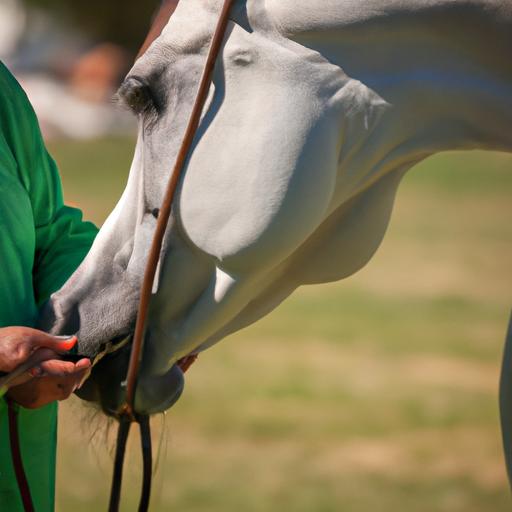Unlock the secrets to successful arabian horse training! Learn best practices, including consistency, positive reinforcement, and understanding their needs.
Arabian horses, known for their elegance and beauty, have captivated the hearts of equestrians for centuries. With their unique characteristics and spirited nature, these majestic creatures require effective training to reach their full potential. In this article, we will delve into the world of Arabian horse training and explore the importance of optimizing training methods using SEO techniques.
A Brief Overview of Arabian Horses

Arabian horses, originating from the Arabian Peninsula, are one of the oldest and most influential horse breeds in the world. Renowned for their distinctive dished face, arched neck, and high tail carriage, these horses exude an aura of grace and nobility. Their compact size, endurance, and intelligence make them versatile athletes, excelling in various equestrian disciplines.
The Importance of Effective Training for Arabian Horses
Training plays a vital role in shaping the behavior and abilities of Arabian horses. Whether you aim to compete in shows, engage in recreational riding, or simply develop a deeper bond with your equine companion, effective training is essential. It allows you to establish trust, enhance communication, and instill discipline, enabling you and your Arabian horse to work harmoniously as a team.
Optimizing Training Methods with SEO Techniques
While traditional training methods have proven effective, it is equally crucial to leverage SEO techniques to optimize your training approach. By incorporating relevant keywords and structuring your content in a search engine-friendly manner, you can increase the visibility of your training materials online. This not only attracts a wider audience but also establishes your expertise and authority in Arabian horse training.
In the following sections, we will delve deeper into understanding Arabian horses, explore basic and advanced training techniques, discuss best practices, and provide valuable insights to help you unlock the true potential of your Arabian horse. So, saddle up and embark on this exciting journey of Arabian horse training with us!
Understanding Arabian Horses
Arabian horses possess a distinct set of characteristics and traits that set them apart from other breeds. By gaining a deeper understanding of these traits, you can tailor your training methods to effectively connect with and train your Arabian horse.
Characteristics and Traits of Arabian Horses
Arabian horses are known for their striking physical features, including a refined head with expressive eyes, a high-set tail, and a compact yet muscular body. They have a natural inclination towards agility and endurance, making them exceptional long-distance runners. Their intelligence, sensitivity, and willingness to please make them quick learners, but also require a gentle and patient approach during training.
Unique Qualities that Make Arabian Horses Different
One of the most notable qualities of Arabian horses is their strong bond with humans. These horses have developed a deep connection with humans throughout history, serving as loyal companions and reliable partners. Their keen intuition allows them to sense the emotions and intentions of their handlers, forging a unique partnership built on trust and mutual respect.
Additionally, Arabian horses possess an incredible spirit and an unwavering desire to please their riders. Their high energy levels and natural curiosity make them enthusiastic learners, always ready to take on new challenges. This combination of intelligence, sensitivity, and an indomitable spirit makes Arabian horses truly exceptional.
How Understanding these Traits Can Help in Training
By understanding the unique traits of Arabian horses, you can tailor your training methods to suit their specific needs. Their sensitivity calls for a gentle and patient approach, focusing on positive reinforcement and clear communication. Building a bond of trust and respect is essential to gain their cooperation and willingness to learn.
Moreover, their high energy levels and intelligence require mental and physical stimulation. Engaging them in various training exercises, such as obstacle courses and pattern work, helps keep them focused and interested. By recognizing and harnessing their innate qualities, you can unlock their true potential and achieve remarkable results during training sessions.
In the next section, we will delve into the basic training techniques for Arabian horses, where we will explore how to establish trust, teach basic commands, and introduce them to different environments. Let’s continue our journey towards Arabian horse training mastery!
Basic Training Techniques for Arabian Horses
Establishing Trust and Building a Bond with the Horse
Building a strong foundation of trust is paramount when training Arabian horses. These intuitive creatures thrive on a deep connection with their handlers. Begin by spending quality time with your horse, engaging in grooming sessions, and offering treats as rewards. Through consistent and patient interactions, you can establish a bond built on mutual respect and understanding.
Teaching Basic Commands and Cues
Once trust is established, it’s time to introduce basic commands and cues to your Arabian horse. Start with simple verbal commands like “walk,” “trot,” and “halt.” Reinforce these commands with corresponding physical cues, such as light pressure on the reins or gentle leg aids. Consistency is key during this stage, as it helps your horse understand and respond to your cues effectively.
Introducing Arabian Horses to Different Environments and Situations
Arabian horses are naturally curious and adaptable. To ensure their success in various environments, gradually expose them to different situations. Begin with low-stress environments, such as an empty arena or a quiet trail, then gradually introduce distractions like other horses or new obstacles. By exposing your Arabian horse to different environments and situations, you can build their confidence and enhance their ability to handle new challenges.
Remember, each horse is an individual, and their training progress may vary. Be patient and adapt your training techniques to suit their unique needs. By focusing on building trust, teaching basic commands, and gradually introducing new experiences, you are setting a solid foundation for further training and development. So, embrace these basic training techniques and watch your Arabian horse thrive in their journey towards excellence.
Advanced Training Methods for Arabian Horses
Arabian horses, with their innate abilities and striking presence, are widely sought after in competitive equestrian events and shows. To excel in these arenas, it is crucial to implement advanced training methods that focus on developing specific skills and disciplines. Let’s explore some key aspects of advanced Arabian horse training.
A. Developing Specific Skills and Disciplines
To unlock the full potential of your Arabian horse, it is essential to identify and nurture their individual strengths and talents. This involves tailoring the training program to focus on specific disciplines such as dressage, show jumping, endurance riding, or even reining. By understanding the unique attributes of Arabian horses, such as their agility and quick learning abilities, you can design training sessions that enhance their natural abilities and refine their skills.
B. Training for Competitions and Shows
Competing in equestrian events and shows requires a high level of precision, grace, and synchronization between horse and rider. Advanced training methods for Arabian horses should encompass exercises and routines that simulate the intensity and demands of competition settings. This includes practicing intricate dressage movements, perfecting jumping techniques, and mastering the art of presentation. Consistency, attention to detail, and regular exposure to show environments are key to preparing Arabian horses for success in the show ring.
C. Addressing Common Challenges in Training Arabian Horses
Arabian horses, like any other breed, may encounter specific challenges during training. These challenges can range from stubbornness and sensitivity to distractibility and overexcitement. Understanding the common hurdles that arise in Arabian horse training allows you to address them effectively. Patience, consistency, and positive reinforcement techniques are crucial in overcoming these challenges and building a strong partnership with your Arabian horse.
As you progress in your Arabian horse training journey, it is important to remember that advanced training methods require a deep understanding of your horse’s capabilities, patience, and a willingness to adapt to their unique needs. By employing these advanced training techniques, you can unlock the true potential of your Arabian horse and achieve remarkable results in competitions and shows.
Conclusion
In conclusion, Arabian horse training is a fascinating journey that requires dedication, patience, and a deep understanding of these magnificent creatures. By following the best practices outlined in this article, you can unlock the true potential of your Arabian horse and forge an unbreakable bond.
Consistency and patience are key pillars of successful Arabian horse training. Remember that Rome wasn’t built in a day, and neither is a well-trained Arabian horse. Stay committed to your training routine and be patient with your horse’s progress. Consistency in your approach will yield fruitful results over time.
Utilizing positive reinforcement techniques is another crucial aspect of Arabian horse training. Rewarding desired behaviors with treats, praise, or a gentle pat on the neck helps reinforce positive associations and motivates your horse to continue performing well. By focusing on rewarding good behavior rather than punishing mistakes, you create a nurturing and supportive training environment.
Understanding the physical and mental needs of Arabian horses is paramount in ensuring their well-being during training. These horses possess tremendous energy and require regular exercise and mental stimulation. Incorporate varied training activities, such as trail rides, ground exercises, and obstacle courses, to keep your Arabian horse engaged and content.
In conclusion, Arabian horse training is an art that combines passion, skill, and a deep connection between horse and handler. By implementing the best practices outlined in this article, you can embark on a remarkable journey of Arabian horse training and witness the transformation of your equine partner. Remember, the key to success lies in your hands and the trust you build with your Arabian horse.
Thank you for joining us on this adventure. For more valuable insights and training resources, visit Horsemasterypro.com. Happy training!


